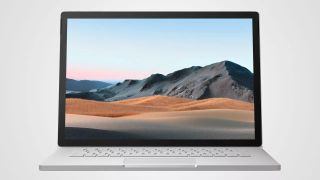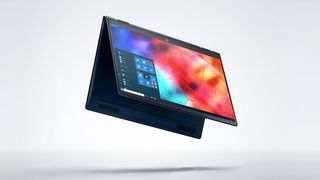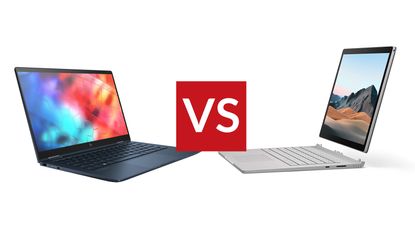If you're shopping in 2022 for a business-focused hybrid laptop-tablet, then shopping with Microsoft or HP is a smart choice. This is because both of these makers have some top-rated, 5-star products on offer.
Right here, we compare two of these maker's tops systems, the Microsoft Surface Book 3 and HP Elite Dragonfly, which feature prominently in our best 2-in-1 laptops buying guide.
So which of these premium devices is your best option? In this article, we’ll compare the two in terms of design, display, specs, connectivity and price, then offer our overall verdict to help you make your decision. We'll also surface today's best deals on these laptops, too.
We’ll start by noting that these are both excellent laptops, and while they might be at the more expensive end of the market, they do represent great value. So choosing between them really comes down to looking at the small differences, and deciding which ones matter most to you.
Microsoft Surface Book 3 vs HP Elite Dragonfly: design and display

Aesthetically, both the Surface Book and the Elite Dragonfly are stunning. Stylish, sleek and professional looking in their different ways, you’d be proud to be seen with them out in public or in a meeting. Both are very lightweight and easy to carry about, too, with the Surface Book weighing 800g (1.8lb) and the base model of the Dragonfly just a little more, at 990g (2.18lb).
There are some significant differences in design, though, and the most important is how they convert to tablet form. The Surface Book 3’s keyboard and screen split into two separate parts, allowing you to use the latter in tablet mode. The Elite Dragonfly, however, folds over rather than detaches, allowing you to convert it to tent mode, lie it flat, or move it into tablet mode with the keyboard under the screen.
And what of the screens themselves? Both are very impressive, although the specs do vary depending on the model you go for. To be specific, the Surface comes with a 13.5-inch, 3000 x 2000 pixels touchscreen with 400 nits of brightness, and there’s also the option of a 15-inch model. (Also note that both displays features a 3:2 aspect ratio, which is squarer than the more standard 16:9.)
With the Dragonfly, meanwhile, you can choose between two 13.3-inch display options: Full HD (1,920 x 1,080 pixels) with 400 nits of brightness, or 4K HDR with 550 nits of brightness. Both these screens offer a standard 16:9 ratio. When it comes to audio, meanwhile, the Bang & Olufsen speakers in the Dragonfly are top quality, and superior to the Surface’s speakers, which are pretty average.
Beyond these design fundamentals, there are a number of small, but important touches that make the Dragonfly more attractive than the Surface. Firsty, it comes with a fingerprint sensor. Secondly, there’s a privacy shutter on the webcam. Thirdly, you get a stylus included in the box. And finally, there’s the option for 4G connectivity on the Dragonfly: you just need to add a SIM card.
Microsoft Surface Book 3 vs HP Elite Dragonfly: processor, storage and graphics

The base model of the Surface Book 3 comes with a quad-core Intel Core i5-1035G7 Processor, but you can pay more to get a more modern i7-1065G7 processor. RAM ranges from 8GB to 32GB LPDDR4x, and SSD storage from 256GB to 1TB. Graphics come courtesy of a Nvidia GeForce GTX 1650 card.
The HP Elite Dragonfly offers a quad-core Core Intel i7-8565U processor, 16GB memory and 512GB on all its models. Unlike the Surface, there’s no discrete GPU, graphics instead provided by the integrated Intel UHD Graphics 620.
Microsoft promises up to 15.5 hours of battery life for the 13.5-inch version and 17.5 hours for the 15-inch model of the Surface Book 3. That is far surpassed, however, by the four-cell, 56.2Wh battery in the Elite Dragonfly, which HP claims offers up to 24.5 hours’ battery life.
Microsoft Surface Book 3 vs HP Elite Dragonfly: connectivity
The Surface Book 3 offers a healthy range of ports to connect up your devices. These include two USB-A 3.1 ports, a USB-C 3.1 with power delivery, a 3.5mm headphone jack, two Surface Connect ports (one on the base, one on the tablet), and an SDXC card reader.
With the HP Elite Dragonfly, you get an HDMI port, a 3.5mm audio jack, two USB-C Thunderbolt 3 ports, either of which can be used for charging, a USB-A 3.1 port, and a Nano SIM slot.
Microsoft Surface Book 3 vs HP Elite Dragonfly: price and verdict

The 13.5-inch version of the Microsoft Surface Book 3 starts at £1,599 / $1,599 for the base model (8G RAM, 256GB SSD and i5 processor), then climbs to £1,999 / $2,499 for the i7 processor, 32GB RAM and 512GB SSD, and £2,699 / $2,699 for 1TB SSD.
The 15-inch version, meanwhile, comes in three models, all with the i7 processor. The base model with 16GB RAM and 256GB SSD costs £2,199 / $2,299; to get 32GB and 512GB SSD is £2,699 / $2,799; and for 1TB SSD it’s £2,899 / $3,399.
With the HP Elite Dragonfly, you have just two models to choose from: the Full HD model for £1,738.80 / $2,011.52 or the 4K version for £1,950 / $2,181.52. Both come with the 13.3-inch screen, the i7 processor, 16 GB RAM, and 512GB SSD.
Lining up these various configurations up against each other, the Surface and Dragonfly seem pretty evenly matched when it comes to price. Yes, the base model of the Surface is considerably cheaper than that of the Dragonfly, but you’re getting a lower-specced setup as a result. So in general we’d say with both laptops, you get what you pay for.
One of your main considerations, then, is simply whether you prefer a laptop screen that detaches as a tablet, or a laptop that folds over into a tablet. Beyond that, the other big consideration will be what you want a laptop for.
The Dragonfly is more squarely marketed at a business audience, and we’d say it’s probably a better bet for this purpose. The privacy shutter and fingerprint sensor are great for anyone concerned about security; the 4G connectivity will help you close that deal while you’re out and about; and the superior battery life will be helpful when travelling for business, or just in a meeting room where there aren’t enough power points.
If you want a laptop for general use, though, and you don’t need to perform processor-intensive tasks such as video editing or 3D animation, you’re probably better off saving the money and going for the base model of the Surface. Even in its cheapest configuration, this high-end laptop is more than capable of handing day-to-day tasks such as surfing the web, editing documents and spreadsheets, streaming video, making Zoom calls and casual gaming.
- Not fussed for 2-in-1 functionality? Then check out the best laptops











